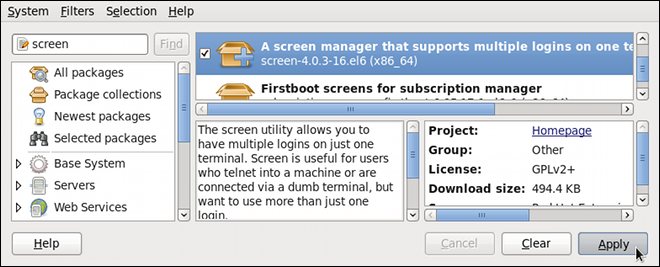Este contenido no está disponible en el idioma seleccionado.
9.2.3. Installing and Removing Packages (and Dependencies)
With the two filters selected, and , search for the screen window manager for the command line and highlight the package. You now have access to some very useful information about it, including: a clickable link to the project homepage; the Yum package group it is found in, if any; the license of the package; a pointer to the GNOME menu location from where the application can be opened, if applicable; and the size of the package, which is relevant when we download and install it.

Figure 9.7. Viewing and installing a package with PackageKit's Add/Remove Software window
When the check box next to a package or group is checked, then that item is already installed on the system. Checking an unchecked box causes it to be marked for installation, which only occurs when the button is clicked. In this way, you can search for and select multiple packages or package groups before performing the actual installation transactions. Additionally, you can remove installed packages by unchecking the checked box, and the removal will occur along with any pending installations when is pressed. Dependency resolution, which may add additional packages to be installed or removed, is performed after pressing . PackageKit will then display a window listing those additional packages to install or remove, and ask for confirmation to proceed.
Select screen and click the button. You will then be prompted for the superuser password; enter it, and PackageKit will install screen. After finishing the installation, PackageKit sometimes presents you with a list of your newly-installed applications and offers you the choice of running them immediately. Alternatively, you will remember that finding a package and selecting it in the Add/Remove Software window shows you the Location of where in the GNOME menus its application shortcut is located, which is helpful when you want to run it.
Once it is installed, you can run
screen, a screen manager that allows you to have multiple logins on one terminal, by typing screen at a shell prompt.
screen is a very useful utility, but we decide that we do not need it and we want to uninstall it. Remembering that we need to change the filter we recently used to install it to in
Warning
Although PackageKit automatically resolves dependencies during package installation and removal, it is unable to remove a package without also removing packages which depend on it. This type of operation can only be performed by RPM, is not advised, and can potentially leave your system in a non-functioning state or cause applications to behave erratically and/or crash.

Figure 9.8. Removing a package with PackageKit's Add/Remove Software window